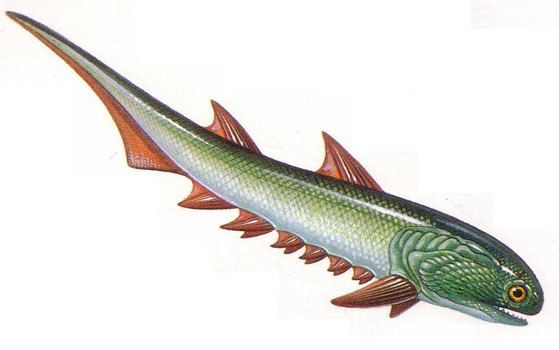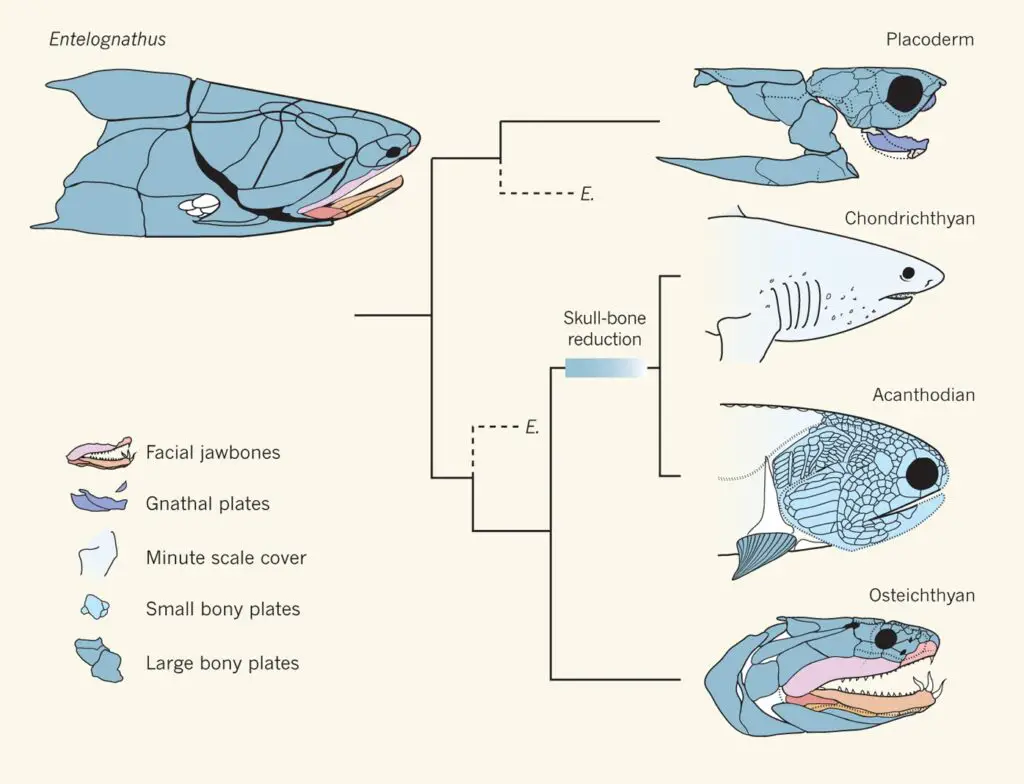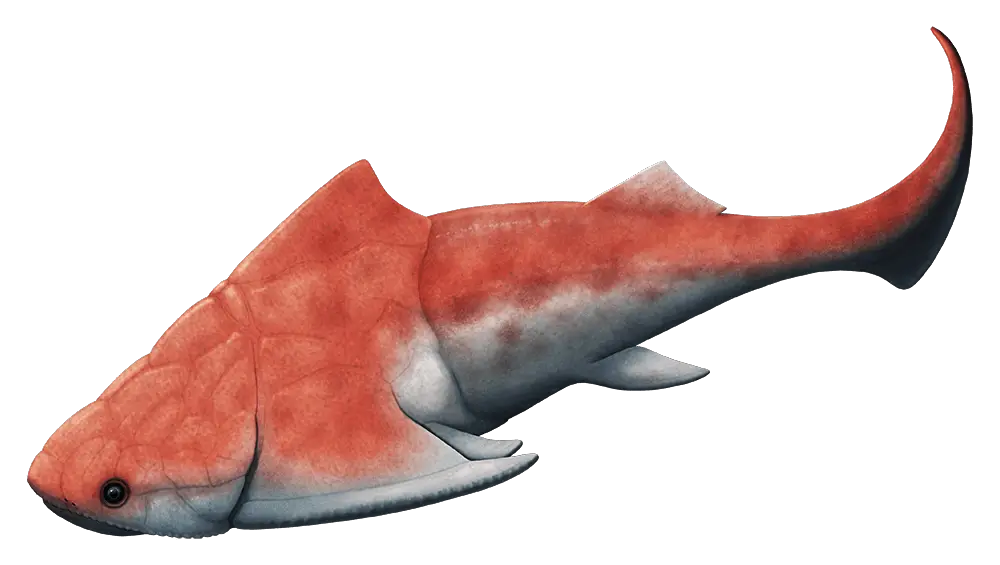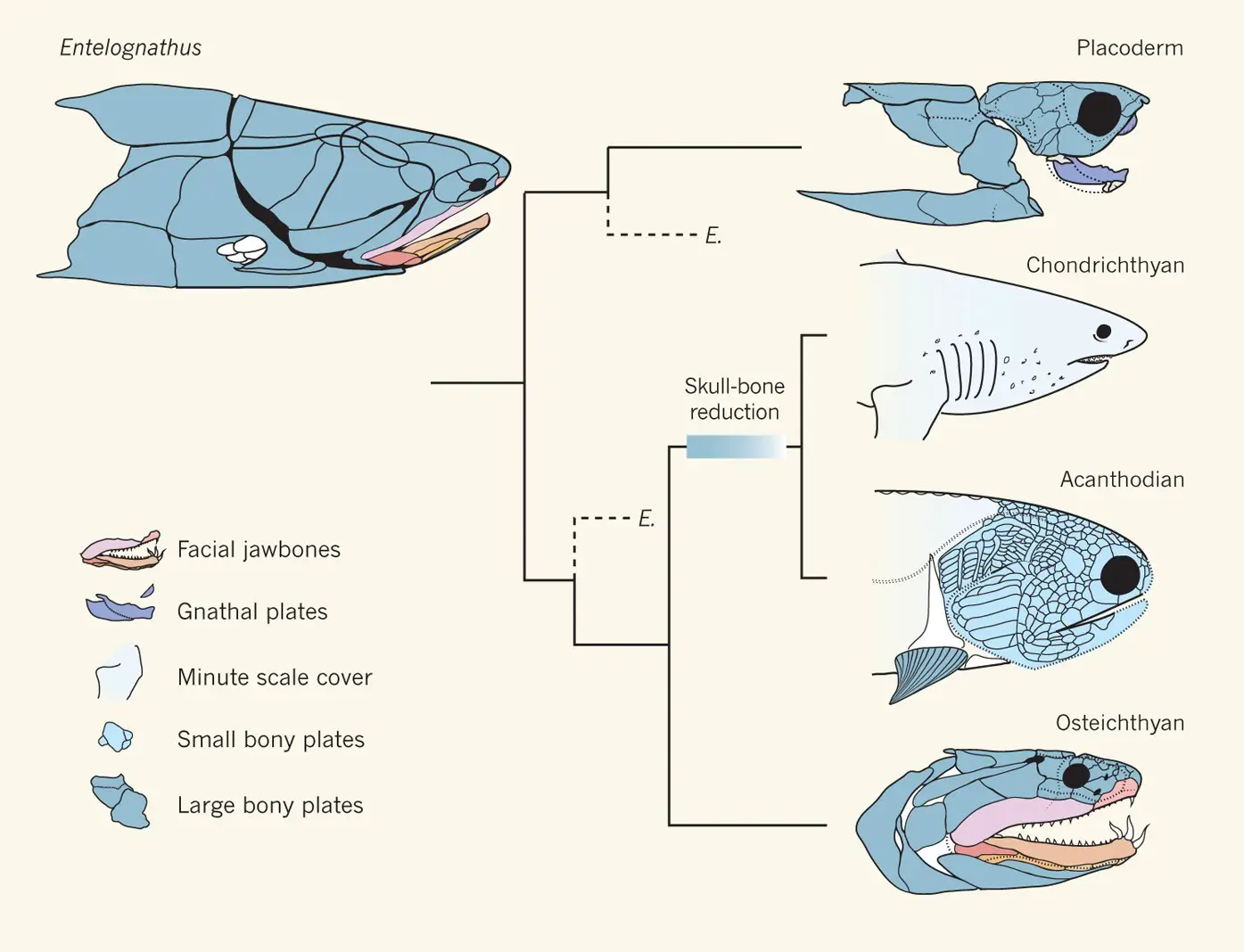Table of Contents
Who are Placodermi:
Placodermi is the first jawed Vertebrate in the history of evolution before all the primitive Vertebrates were jawless. Before Placodermi all the primitive Vertebrate paired appendages was absent but the paired appendages and strong jaw make them powerful predator. Ostracoderms become extinct approximately 450 million years ago when the first time Placodermi arrive on our earth.
Around mid-Silurian when the jawless armour fish or Ostracoderms become extinct, Placodermi becomes dominant. Placodermi is a very efficient jawed fish with paired fins, the bony armour was not prominent as in Ostracoderms but we can see traces of bony armour on Placodermi also. In Placodermi the bony armour generally covers the body part, we also can see scales on their body parts.

Due to their strong jaw and paired fin, they become very powerful predators soon but they also did not exist for a long time. Placodermi becomes extinct so quickly that most of the workers title the event of extinction of Placodermi as an “unsuccessful ancient experiment“.
Timeframe of Placodermi:
Around 450 million years ago during Silurian the primitive armour bony fishes, Ostracoderms become extinct but they left their continuity in Placodermi. We do not have living evidence for the primitive Vertebrate, even we do not have evidence of very early Vertebrate.
So it is very difficult to solve the puzzle about the exact timeframe when they arrive on our earth. But from the fossil evidence we have, we assume that Placodermi was present much earlier than the extinction of Ostracodermi, Placodermi arrive on our earth during the Silurian period.
Due to their strong jaw and paired fin, they flourished soon and reach peak level during Devonian and Carboniferous but suddenly in Permian, they become extinct suddenly. We have evidence that Placodermi was present in both marine and freshwater, some workers believe that Placodermi evolved from Ostracoderms.
Previously most of the workers assume that Placodermi came after the extinction of Ostracodermi but modern research shows that there is no direct connection between Ostracoderms and Placodermi. We do not have any clear intermediate between Placodermi and Ostracoderms and before Ostracoderms Placodermi was present in evolved form. So we can not say that jawed Ostracoderms evolved from the jawless Ostracoderms.

For now, we do not have any strong evidence which can give us a clear idea about the ancestors of Placodermi and we are unaware of the intermediate between Placodermi and primitive jawless Vertebrate. Due to insufficient fossil evidence, the Ancestry of Placodermi are not clear but we hope in future we will be able to know more about the evolution of Placodermi from the primitive jawless Vertebrate.
Characteristics Features of Placodermi:
Some features in Placodermi have very much similarity with Ostracoderms which leads to thinking most of the workers that Placodermi evolved from Ostracoderms. Especially the traces of bony armour present partially on the head and trunk in Placodermi but in Placodermi, some very important Vertebrate features arrived.
Bony Exoskeleton (Bony Armour):
Placodermi shows very much diversity in their shape and size but if we notice carefully then we will find that bony armour is common in almost all species of Placodermi. For example, the Giant Predator Dunkleosteus is a large-sized Placodermi, they reach around 10 meters. Dunkleosteus show armour on their head and a certain part of the trunk covered by heavy bony plates but the remaining part of the trunk and tail remain uncovered.
The name Placodermi was given to them due to the bony plate on their skin which means, the skin is covered by a plate-like structure. This bony armour establishes a link between Ostracoderms and Placodermi but actually, the evidence says that Placodermi was present in well evolved from before extinction of Ostracodermi.
Placodermi show similarity in external appearance with Ostracoderms but the major difference between them is Ostracoderms were jawless armoured fish while Placodermi is jawed armoured fish.
First Jawed Vertebrate:
The first time we can see jaw in Placodermi before Placodermi all the primitive Vertebrates were jawless, the strong jaw of Placodermi make them successful. The first pair of gill bars modified into the jaw and the jaw has special support of hyoid arch, such type of support is known as aphetohyoidean type.
The powerful jaw of Placodermi gave them extra advantages over the non-jawed Vertebrate, with their jaw they were able to manipulate any object easily. The strong jaw makes able them to defend themselves against their predator so with time the need for bony armour reduces. The heavy bony armour start to disappear with time which makes them able to swim faster, those features make them dominant over jawless Ostracoderms.
Paired Fin:
Before Placodermi, all the primitive Vertebrates have unpaired median fins but first time in Placodermi paired fins appear which makes them fast swimmers. The paired fin gave them much stability in a certain plane in the water, with the help of lateral paired movable fin they can move in any direction swiftly – upward, downward, right, left.
The paired fin protect them against whirling due to the turbulent flow of water and give very much stability in water, the strong jaw and paired fin make them a powerful predator. But Placodermi did not exist for a long time they become extinct so quickly, the reason behind the extinction of Placodermi is not clear. Some workers believe that the jaw of Placodermi was jointed at a point that makes their jaw limited and the evolution of teethed Acanthodian push Placodermi towards extinction.
Classification of Placodermi:
Workers when try to classify the members of Placodermi into different categories then they face difficulties because all the members of Placodermi are now extinct, only fossil evidence is the base of classification. Different workers tried to classify them in different ways which results in different classification schemes and we will try to give you the updated classification of Placodermi.
Subclass Acanthodii:
- Acanthodian are almost similar to Ostracoderms in external appearance and they were the most primitive jawed Vertebrate.
- The head is covered by bony armour and it is jointed to the bony armour of the trunk.
- Members of Acanthodii are also known as ‘spiny shark’ because between pectoral and pelvic fin paired spine like structure present laterally.
- The body shape and heterocercal tail give them shark like appearance, due to their strong jaw they were very aggressive predator.
- Members of Acanthodii are generally freshwater habitants and they become extinct in lower Devonian.
Subclass Arthrodira:
- Arthrodira show a protective covering on their head which makes a cranial roof, trunk is partially covered by bony armour and partially covered by scales.
- The body is elongated and the tail is whip like slender and long, the body shape give them extra swiftness during swimming.
- The branchial arche is covered by operculum, presence of operculum is a advanced features.
- Croccosteus, Dinicthys, Arctolepis, Mylostoma are some important examples of subclass Arthrodira.
Subclass Petalichthyida:
- Members of Petalichthyida are very much similar to the primitive elasmobrach, specially the tribasal pectoral fins, shoulder girdle are common in them.
- The flattened neurocranium and ventrally positioned mouth show that they are bottom deweller.
- Lunaspis and Macropetalicthys are two important members of subclass Petalichthyida.
Subclass Pterichthyomorphi:
- They are small sized freshwater Placoderms present in large numbers in Devonian.
- The presence of lungs like sac which is connected to pharynx is a important feature of this subclass.
- On the head mouth present ventrally, the eyes are present much closer to each other dorsally.
- The tail part is completely covered by scales, some important examples of this subclass are Bothriolepis, Microbrachius and Ceraspis.
Subclass Rhenanida:
- The body shape is almost look like rays, the head is broad and dorso-ventrally flattened body.
- The body is covered by small bony plates and the bony plates have denticles.
- Large sized pectoral fin is supported by elongated radials, the gill is covered by operculum, spiracle absent.
- Asterostens, Gogorina and Gemuendina are some examples of this subclass.
Subclass Paleospondylia:
- The segmented bony vertebral column and dorso-ventrally flattened skull are the important feature of this subclass.
- The body is covered by bony armour completely and the tail is heterocercal.
- The vertebrae on posterior side of the body show well developed neural arch, central and haemal spine.

Biological Significance of Placodermi:
The evolution of Placodermi is the result of modern fish, the Placodermi have bony armour-like Ostracoderms. But in Placodermi first time jaw appeared, the paired fin also appeared in Placodermi. According to some scientists, the development of the jaw was the most important event in the evolution of Vertebrate, the paired fin and jaw make them very successful. Later when teeth appear in Acanthodii then they become more powerful and with time they evolved into modern fish.
According to some workers Placodermi evolved with time and give rise to the cartilaginous fish and bony fishes separately. But there is no such evidence and previously most of the workers believe that cartilaginous fish are more primitive than bony fishes. But later we find that the bony fish are more primitive than cartilaginous fishes so the concept of the evolution of bony fishes from cartilaginous fish is not valid now.
Reference Class Placodermi General Characteristics Classification Phylogeny
Detailed Study On
Biological Significance of Placodermi
Characteristics Features of Placodermi
Hi Everyone!!! Welcome to Imaluop. Imaluop always try to learn some new and he want to share to other people. Here we will try to learn various topics on Science, specially on Biological Sciences.
